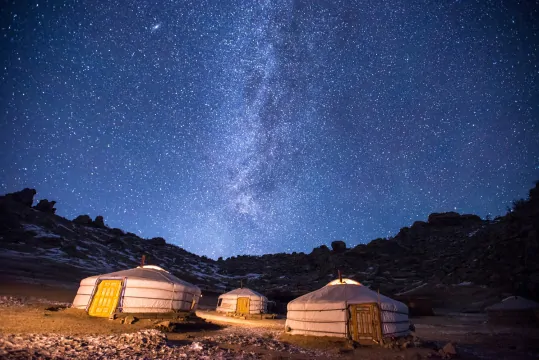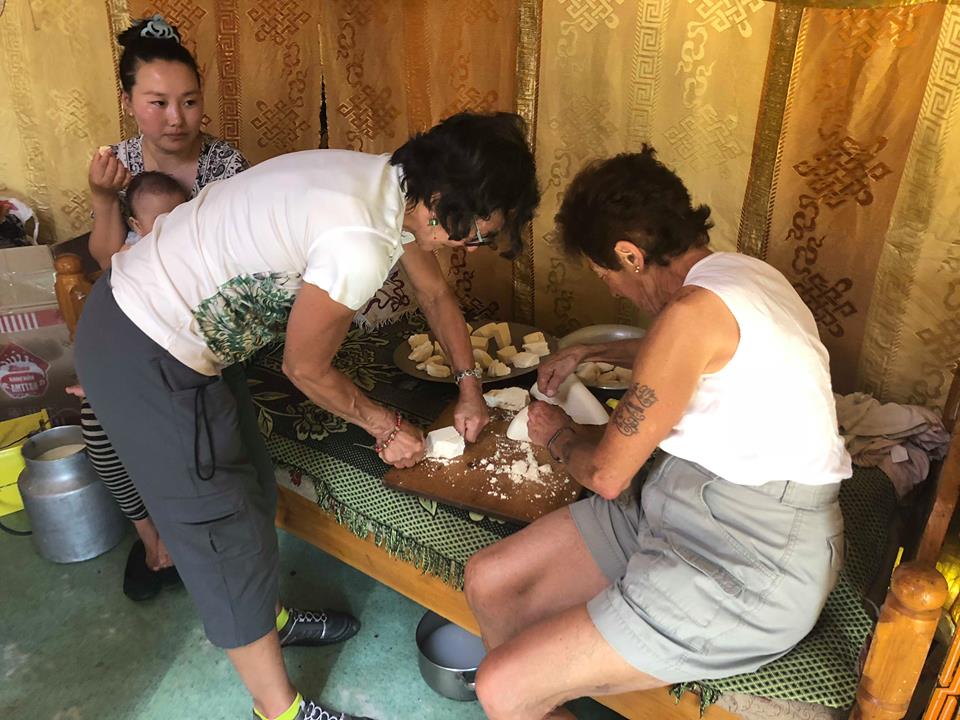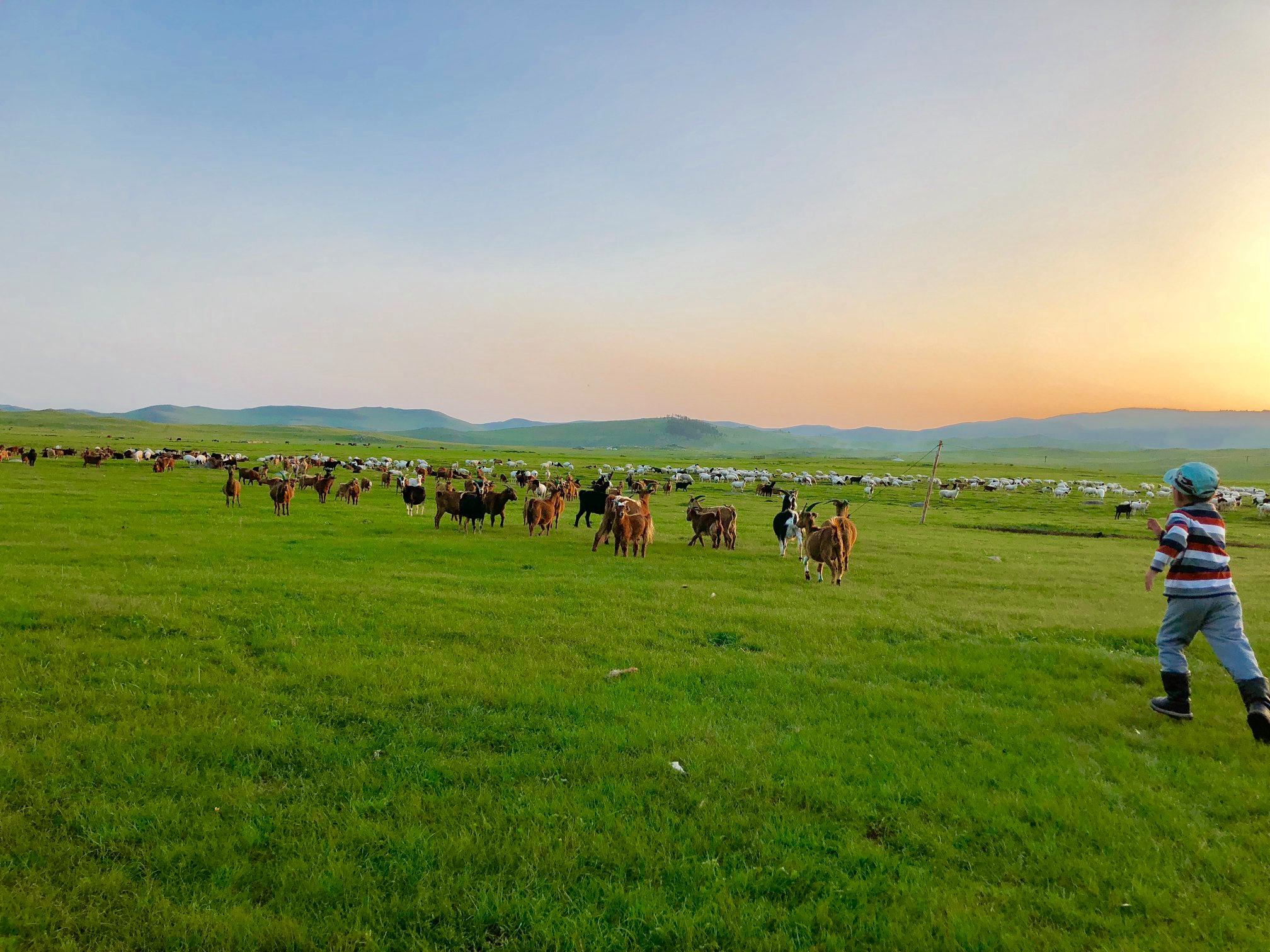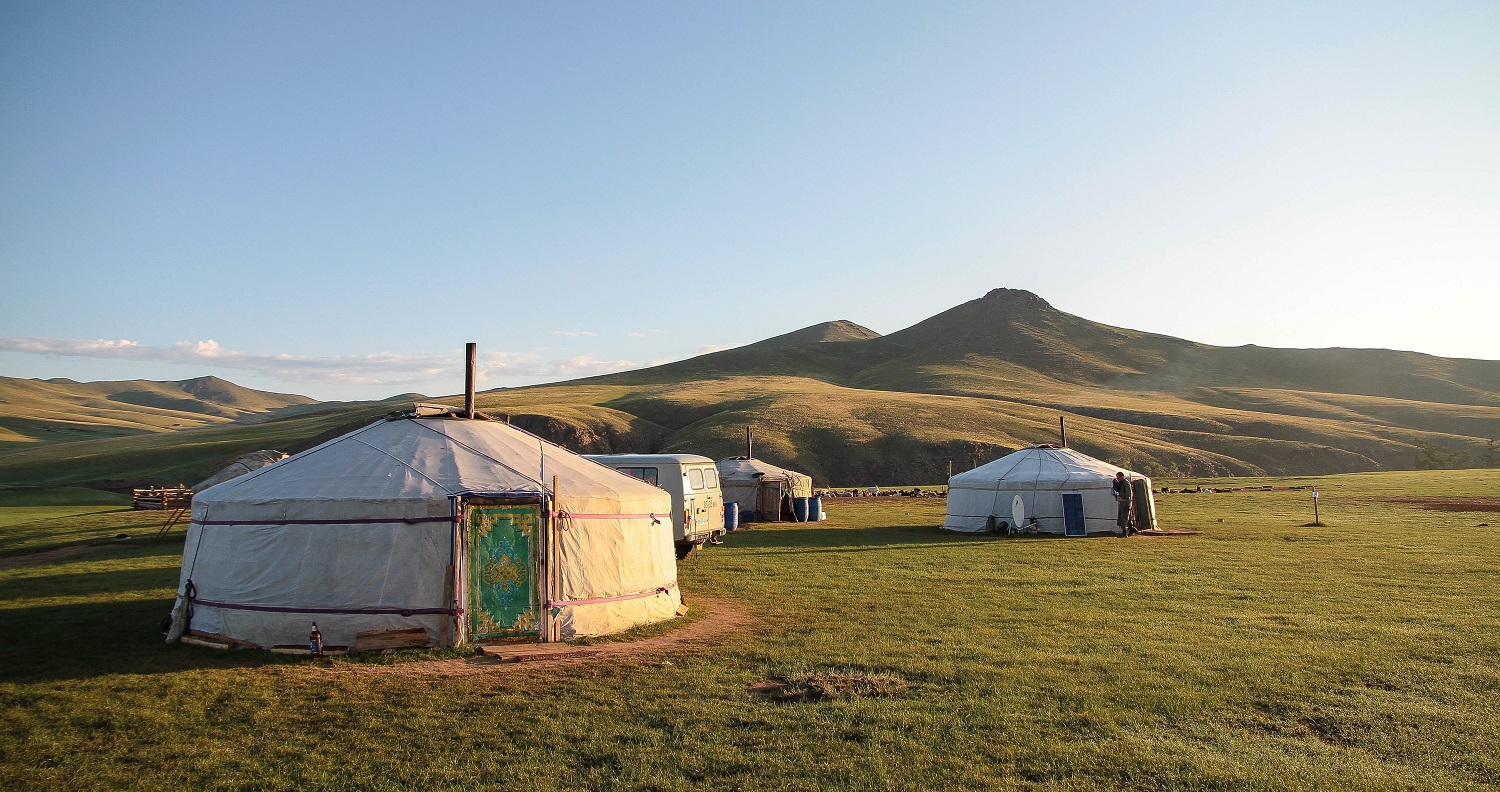

6days/5nights
Tour grade: Easy






Style: Join in Group Tour
A defining feature of Mongolia as a country is its timeless nomadic lifestyle, preserved since the days of the Mongol Empire. Even in the 21st century, amidst the rapid progress of science and technology, Mongolian nomads steadfastly maintain their traditions, tending to their livestock and migrating year-round in search of fertile pastures.
Our trip offers an incredible opportunity to immerse yourself in their culture, traditions, and hospitality by living in a traditional Ger for a few days and experiencing their unique way of life. You'll have the chance to share in their joy and learn about their fascinating history and customs firsthand.
Mongolian people have maintained their nomadic lifestyle for thosands of years, regularly moving their camps to find fertile pastures to feed their livestock. It is fascinating to witness how they tend to their animals in the extreme climate of Mongolia, and how they make dairy products, which are an important part of their traditional diet. Additionally, the Ger remains their favored dwelling to this day.
The "Nomadic Family Stay" short tour by Selena Travel Mongolia offers an authentic and comfortable experience of Mongolian nomadic culture, carefully designed to preserve and respect the traditions and lifestyle of the local people.



Arrival in Ulaanbaatar
Arrive in Ulaanbaatar, your guide meet you at the airport after custom formalities and transfer you to your accommodation. In the afternoon, we will head to the Giant Genghis Equestrian Statue located in Tsonjin Boldog where you can visit museums and climb to the horsehead for the panoramic view of the surroundings. Later, we will return to Ulaanbaatar and enjoy dinner at a local restaurant. Overnight at the hotel in Ulaanbaatar.
Accommodation
Meals Included
Note: Standard check-in time at the hotel is 2 pm. If you require an early check-in, an additional cost may apply.
Nomadic Family via Elsen Tasarkhai sand dunes
Early in the morning, your guide will meet you at your hotel and start the trip to the Nomadic Family. Along the way, we will stop at Elsen Tasarkhai (Bayan Gobi) and the Khugnu Khan nature reserve, where you can see the gorgeous Rocky Mountains and a mini version of sand dunes. We will also try one hour of camel riding in the sand dune areas. After that, we will continue to drive to a nomadic family, where we will arrive and have dinner with the family members. You will stay overnight in your own Mongolian traditional ger, which is located next to the nomads' ger.
Accommodation
Meals Included
Day two of Nomadic Homestay
After breakfast, you will assist the family in their daily routines, such as herding sheep and milking cows. Nomadic families in Mongolia typically raise livestock such as cows, yaks, horses, sheep, and goats. They often milk their animals in the morning and evening and spend the day herding and grazing them. For lunch, you will learn to make Buuz (steamed dumplings) and enjoy your first homemade Mongolian meal. In the afternoon, you will take a walk to collect dung and explore the surrounding wilderness.
Accommodation
Meals Included
Day three of Nomadic Homestay
Today, you will continue experiencing the everyday life of the nomads. You will rise early to assist the housewife with cow milking, herd sheep on horseback, admire the beauty of nature, and learn how to identify the age and color of sheep and goats. You will also learn about dairy food production, such as yogurt and dried curds. In the afternoon, we will drive to the ancient capital Karakorum and visit the legendary Erdene Zuu monastery, which was the first Buddhist monastery in Central Mongolia founded in 1586, as well as its surroundings. Afterwards, we will drive back to the nomadic family and participate in daily household chores, such as fetching water from a nearby stream and chopping wood.
Accommodation
Meals Included
Ulaanbaatar
After breakfast, we will say goodbye to the hosts and drive to Ulaanbaatar with a lunch stop at a ger camp/ local restaurant. Upon arrival, you will visit the Genghis Khan Monument located on Sukhbaatar Square and the National Museum of History which houses a rich collection of artifacts and exhibits that showcase the country's fascinating past. In the evening, enjoy a farewell dinner at a local restaurant.
Accommodation
Meals Included
Departure from Ulaanbaatar, Mongolia
You will be transferred to the airport/train station after breakfast. End of service.
Meals Included
Tour Dates:
Tour Status: Active
*Active: This tour is currently open for new bookings and will be guaranteed to proceed once it reaches the minimum number of participants.
*Guaranteed: This departure is open for new bookings, and it is confirmed to proceed without needing to reach the minimum number of passengers required.
If you prefer a private tour experience, simply click the "Customize this tour" button located at the bottom of the page to personalize the itinerary according to your preferences. Upon submitting your request, our team of travel advisors will promptly provide you with a tailored proposal and quote.
Tour Price:
**The above tour price is not applicable between July 5-15 due to Naadam Festival
Included services :
Not Included in the Service
Accommodation info on your Mongolia tours
Ulaanbaatar: Ulaanbaatar, the capital city of Mongolia, offers a variety of hotels ranging from basic guesthouses to high-end 5* hotels.
Some of our Mongolia tours do not include hotel stays in Ulaanbaatar in the tour package, where clients can choose a hotel that suits their needs and budget. Please make sure to check your tour program`s Inclusions and Exclusions section to confirm if your hotel stay is included in the package.
If you wish us to book your hotel for you, your travel consultant will be happy to recommend and book an ideal hotel for you.
Here are the hotels that are recommended by us:
Outside Ulaanbaatar: Outside of Ulaanbaatar where there are no hotels, tourist Ger (yurt) camps are the best accommodation for travelers. A Ger is a Mongolian traditional dwelling made of felt layers and wooden construction, and the Mongolians have lived in Gers for thousands of years. Tourist Ger camps offer comfortable Gers with 1-3 beds with good bedding (1 Ger equals 1 hotel room), and also offer well-maintained public western-style showers and WCs on their grounds. Some Ger camps offer en-suite bathroom facilities at an additional charge, please ask your Selena Travel advisor for further details when booking your Mongolia tour.
Food on Selena Travel tours
In the capital city of Ulaanbaatar, a great variety of restaurants can be found and you will be eating at some of the best restaurants in Ulaanbaatar on your Mongolia tour while in the capital. Once you are outside the capital, Ger restaurants in Ger camps, local cafes in the small towns and sometimes nomadic families will be the places where you will be eating most of your meal. Ger restaurants often offer set continental breakfasts, set menu lunches, and dinners consisting of salad or soup, main course, and dessert.
While on the tour, during your longer driving days, you will take packed lunch from Ger camps, often a vegetable salad, main courses such as fried chicken/noodles/dumplings, and a small dessert, while hitting the road. Most of the food restrictions and allergies such as vegetarian, vegan, gluten free and many others, can be accommodated with ease on your Mongolia adventure.
Luggage allowance on Selena Travel tours
If you are on an overland-only tour across Mongolia, the recommended weight of your luggage is 20kg per person (max). However, kindly note that domestic flight luggage allowance per person is 15 kg (10 kg for the check in luggage and 5 kg for the carry on luggage). It is possible to purchase extra luggage space which costs US$2 - 5 per 1kg.
Mongolian nomads inhabit the entire country respecting nature, living in gers, breeding livestock- sheep, goat, horse, cow, yak, and camel, moving for good pasture and good water for their animals, living from the products they produce, galloping on horseback... This is the life the great nation has lived since time immemorial, conquered half of the world and they have perfected it through the centuries.
About 5-6 people make average nomad Mongolian family and live in a ger altogether until the children get married. Nomads of Mongolia move on average 6-8 times a year, depending on the weather, pasture, and precipitation. If the weather is good and there's enough rain for the pasture nomads don't need to move far away.
When the nomads of Mongolia move they load camels, camel carts, horse carts or yak carts with their gers, furniture, and other equipment and chase their animals on horseback. But nowadays instead of carts nomads of Mongolia mostly use trucks. Modern nomads enjoy their satellite dish and TV, motorbikes and cars, entertainment and traditional celebrations, animals, and their happy life so much.
GIANT CHINGGIS EQUESTRIAN STATUE
The Tsonjin Boldog statue is a 40m high monument that sits on a 10m high foundation and is surrounded by columns. The statue depicts Chinggis riding his horse and is made of 250 tons of steel, making it the largest horse-riding statue in the world. Chinggis Khaan is depicted holding a golden whip in his right hand, and the building is supported by 36 columns that symbolize the 36 kings who are direct descendants of Chinggis Khaan.
|
|
ELSEN TASARKHAI SAND DUNESElsen Tasarkhai is located on the border of 3 provinces, namely Tuv, Uvurkhangai and Bulgan provinces and stretches over 80 km long territory. The dune is divided by the main road into Mongol Els on the south of the road and Khugnu Tarniin Els on the north side. Due to its location in Central Mongolia, the dunes contrast with green steppes and Rocky Mountains in the background which makes it one of the most beautiful destinations in central Mongolia. The proximity to the capital Ulaanbaatar also makes it among the most visited sites. A state protected national park Khugnu Tarna is also located in the area where one can visit the Erdenekhamba monastery.
|
|
THE ANCIENT CAPITAL KARAKORUMThe ancient capital of Mongolia, Kharkhorin, was established in 1220 by Genghis Khan in the Orkhon Valley. It served as the capital of the united Mongol tribes for 140 years until it was destroyed by Chinese troops in 1391. The remains of the capital that stood at the crossroads of the Silk Road are extensive underground archaeological assets and two granite turtles that once stood at the main gate to the city. Four of these turtle sculptures used to mark the boundaries of ancient Kharkhorin, acting as protectors of the city (turtles are considered symbols of eternity).
ERDENE ZUU MONASTERY Erdene Zuu is the first Buddhist monastery in Mongolia, built on the ruins of the 13th century capital in 1586. The vast walls of the monastery, 400m in length, are surrounded by 108 stupas and are considered symbols of Karakorum. Although time and history have not been kind to the monastery, it still provides a great insight into Mongolia's rich religious and cultural past and carries traces of its former glory.
|
|
NATIONAL MUSEUM OF MONGOLIAThis organization is responsible for collecting, conserving, and interpreting objects related to Mongolian history and culture. Their exhibitions cover a range of topics, including prehistory, the Mongol Empire, and twentieth-century history. They also have significant displays of traditional Mongolian dress and snuff bottles in their ethnographic collection.
|

by Rafaella, Benedetta, Lidia

by Margaret Suganda
Let us design that dream vacation for you